Potstickers
These homemade Pork Potstickers feature a flavorful pork and cabbage filling. They’re pan-fried and steamed to perfection, for golden crispy bottoms and a tender juicy filling. Enjoy them with an easy soy & vinegar dipping sauce as an appetizer or main entree!
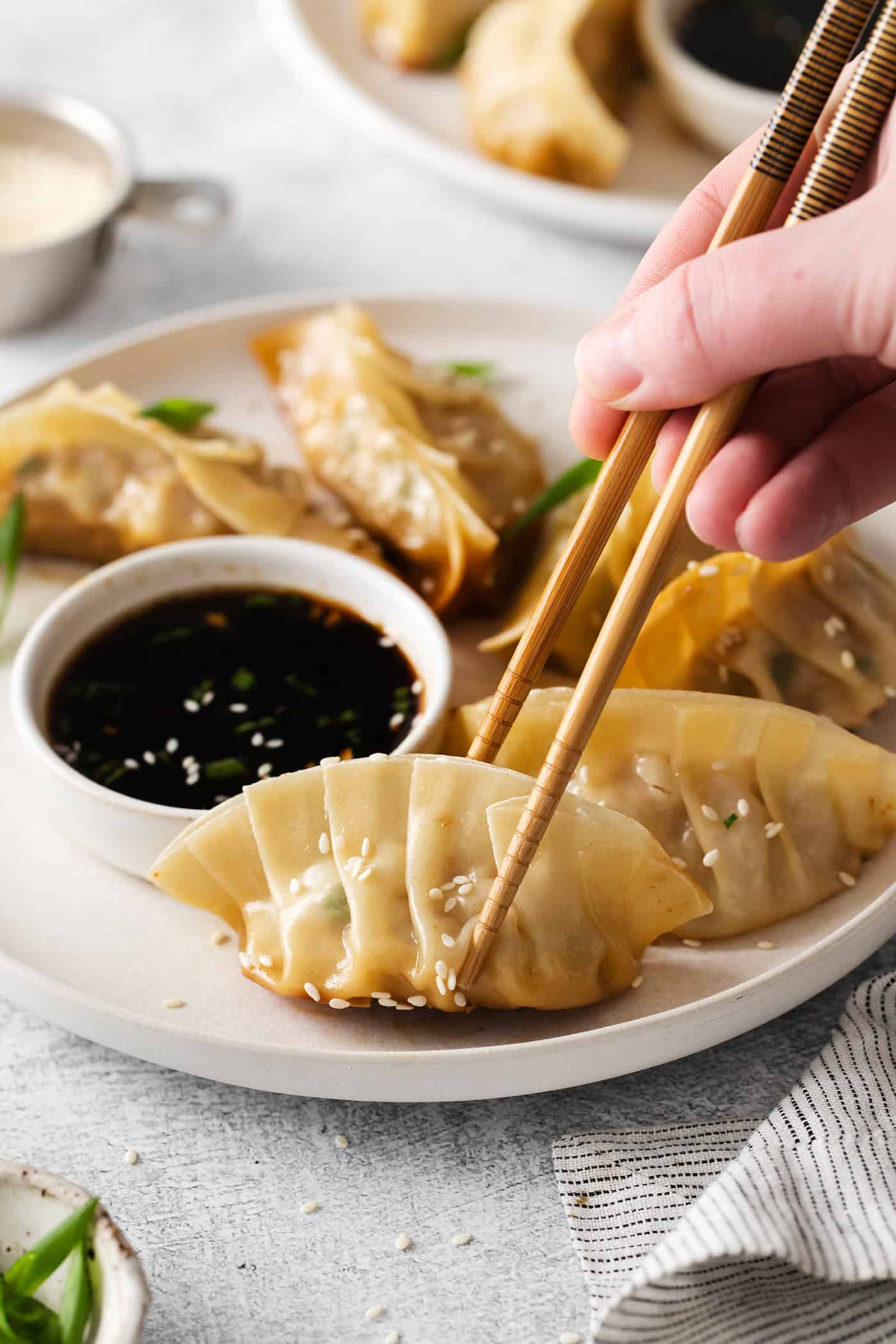
Easy Pork Potstickers
Pork Potstickers have been a longtime favorite appetizer for our family. Filled with juicy pork and cabbage, with gorgeous golden crispy bottoms, we canNOT resist these delicious little dumplings!
When we see potstickers on a restaurant menu, it’s like some kind of gravitational pull, begging us to order them. So I love that we can make them at home – it’s such a fun way to spend time together in the kitchen!
While traditional pork potstickers can take a significant amount of time to make, using homemade dumpling wrappers – I take the easy route by using pre-made potsticker wrappers. The potstickers still taste amazing; I’m not gonna waste any time regretting that decision!
If you’ve never pleated potstickers before (those pretty folds that hold in the dumpling filling), it’s really very easy. I even included a handy little video to show you how.
We love potstickers so much that we always make a double batch. We freeze half of them, for a super easy homemade potstickers meal a little farther down the road. Now how smart is that?!
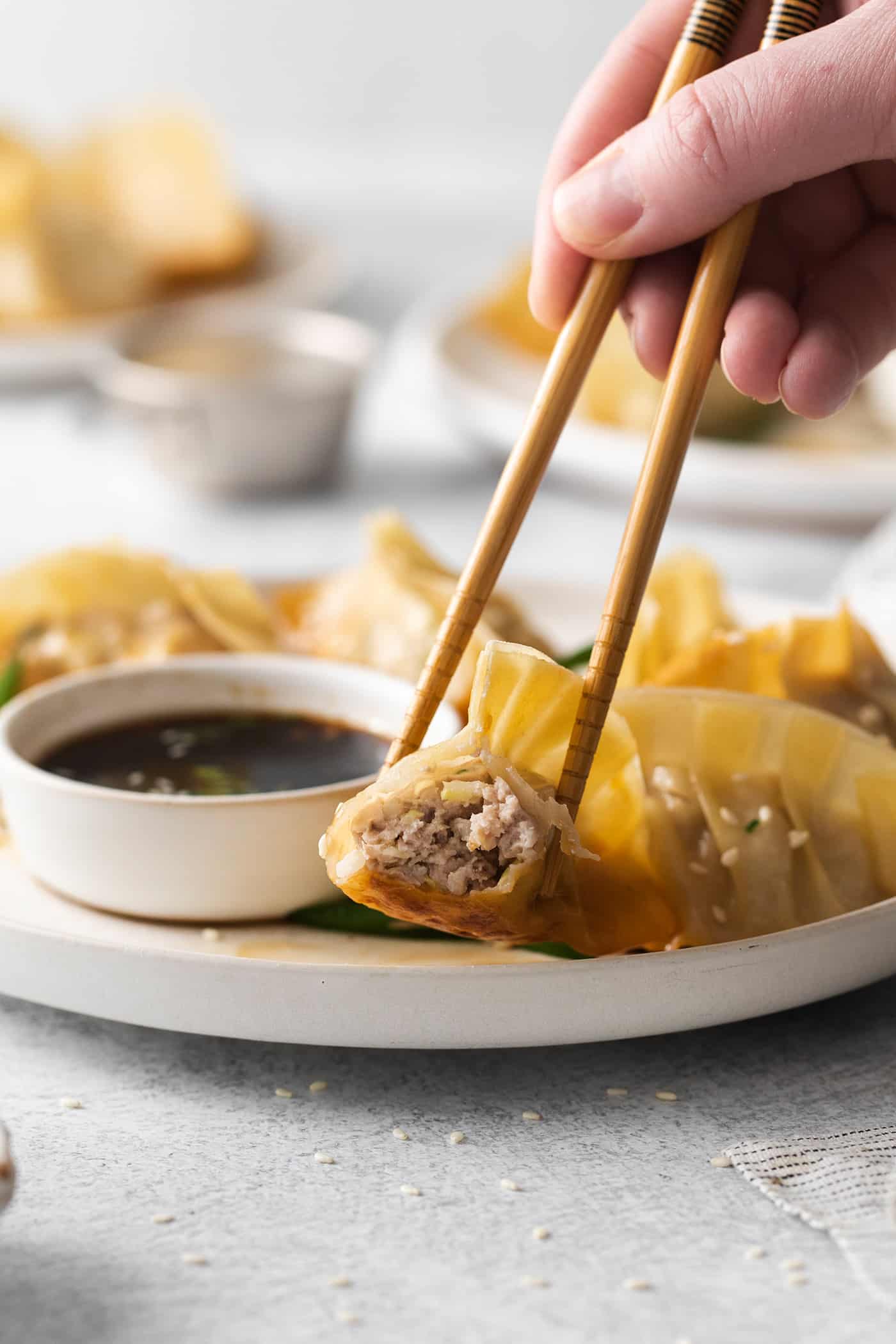
What Are Potstickers?
Potstickers are savory Chinese dumplings (similar to Japanese gyoza) that feature a thin dough wrapper that’s usually filled with ground pork and shredded cabbage.
First, the dumplings are pan-fried. In this step they stick slightly to the pan – and this is what creates that irresistible crispy texture on the bottom of the potsticker. Get it? >>> Pot. Stickers. 😀
Next, the dumplings are steamed. This results in a juicy filling inside the tender pleated dough.
These delectable little bites are not only delicious, but also pretty, as they are often folded into a pleated crescent shape. But they can also be folded in half with no pleats, for simplicity. The pleats are a series of small folds that pinch the sticky dough wrapper together, to keep the filling inside the dumpling.
Potstickers are most often served with a soy dipping sauce. I’ve included a tangy little soy-based sauce with this potsticker recipe, but feel free to simply use soy sauce only.
Why Are Potstickers Enjoyed On The New Year?
Potstickers are frequently enjoyed on the Lunar New Year as it’s said that they represent prosperity, wealth, and good luck. Some say that their shape resembles ancient coins. And certain fillings can also represent certain things, depending on the culture.
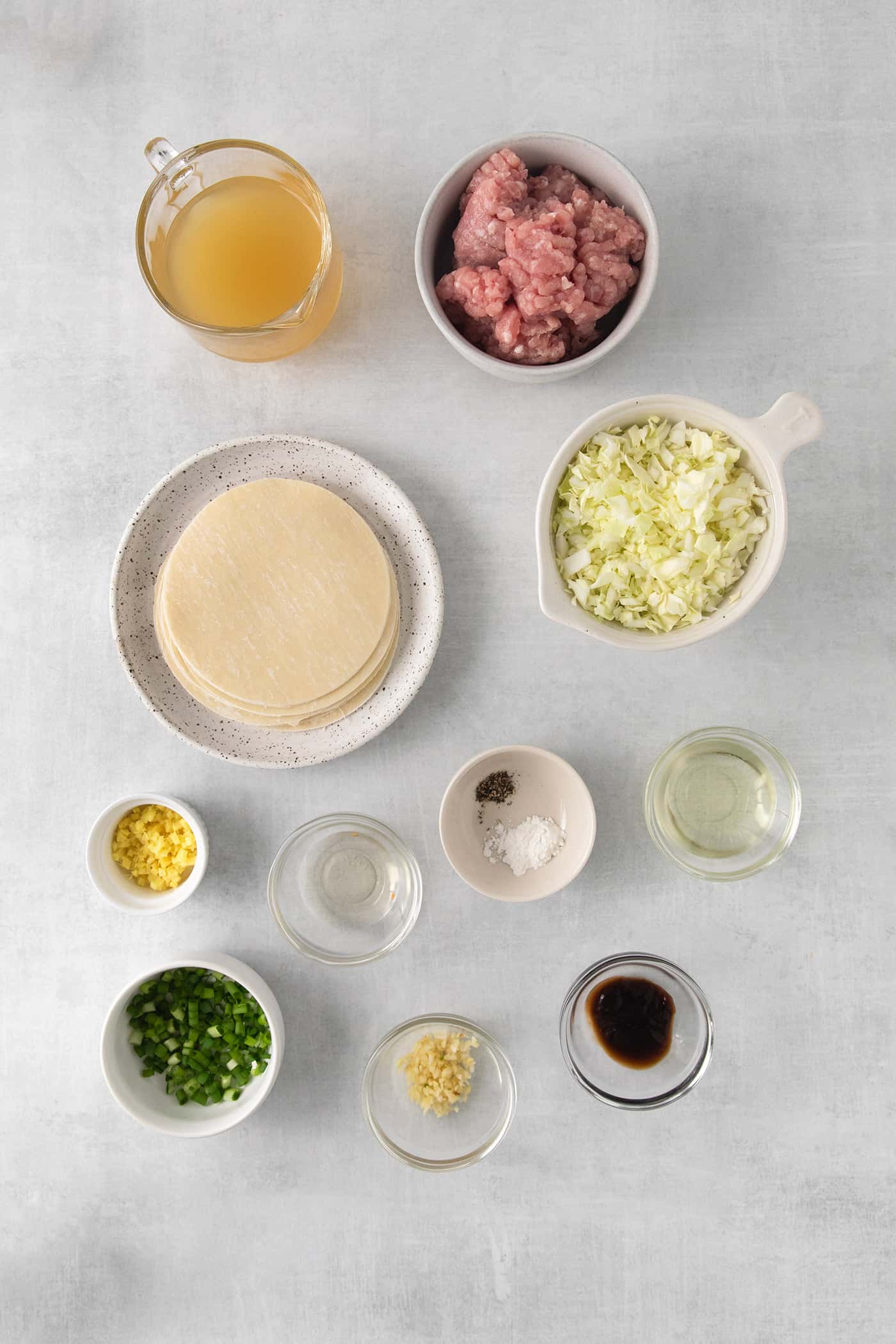
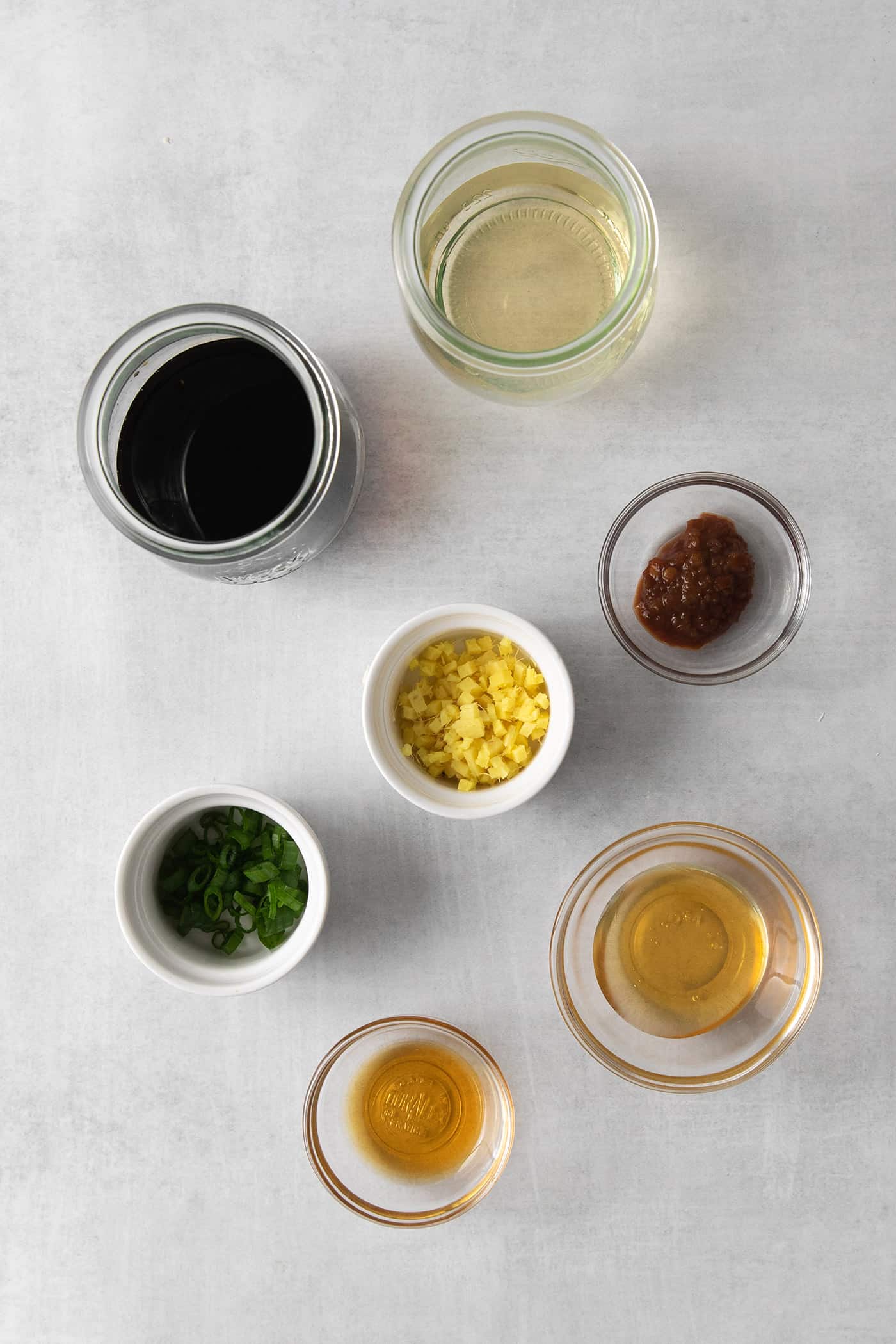
Recipe Ingredients
Here’s what you’ll need for both the pork potstickers and the dipping sauce. See the recipe card below for the measurements.
For the Potstickers:
- Ground pork – You can also use ground chicken or turkey.
- Cabbage – A classic filling that adds flavor and texture to the filling.
- Green onions, garlic & ginger – Fresh flavors that add incredible flavor.
- Rice vinegar – Adds a touch of bright tang to the filling.
- Oyster sauce – This gives an extra nudge of savory flavor to the filling.
- Cornstarch – A small amount is added to the filling – this is the secret to tender, juicy insides. Also use a little cornstarch to dust a rimmed pan – this is for the finished (not yet cooked) potstickers to rest on, so the potstickers don’t stick to the pan. Alternatively, you could line the pan with parchment paper.
- Black pepper
- Potsticker wrappers– Usually found in the refrigerated section of fresh produce at the grocery store.
- Peanut oil – Vegetable oil will also work.
- Chicken broth – I recommend a low sodium variety for this recipe.
For the Dipping Sauce:
- Rice vinegar – The bright, tangy base to the sauce.
- Soy sauce – Adds the classic umami flavor.
- Honey – Sweetens the sauce just a bit.
- Chili garlic sauce – Adds some heat and flavor. Feel free to add as little or as much as you like.
- Sesame oil – I recommend a “toasted sesame oil” for its richer flavor.
- Green onion & ginger – For fresh flavor.

Easy Variations
While classic potstickers are made with pork and cabbage, there are endless variations you can make. Here are a few ideas:
- Switch up the protein. Instead of ground pork, try ground chicken or turkey, ground beef, or chopped shrimp.
- Try vegetarian potstickers. In place of the meat, use finely chopped mushrooms.
- Try different vegetables. Spinach, kale, bok choy, carrots, water chestnuts, and different types of cabbage are all popular additions.
- Add some heat. If you like a little kick of heat in everything you eat, sprinkle some dried pepper flakes into the filling and/or add some extra chili sauce to the dipping sauce.
- Add some kimchi. For a very different take on traditional flavor, try adding some kimchi in place of the cabbage. Just be sure to drain the liquid off first.

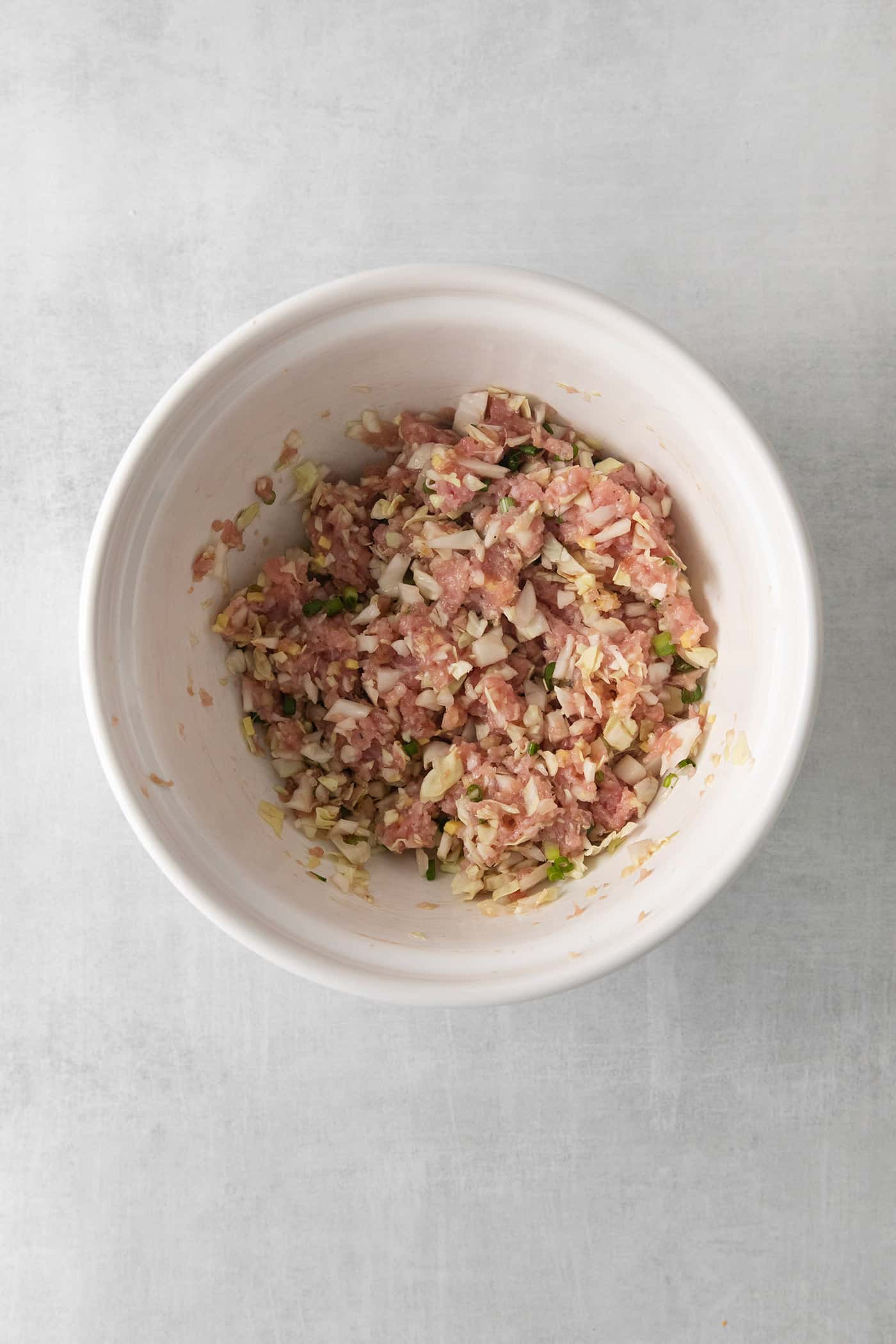
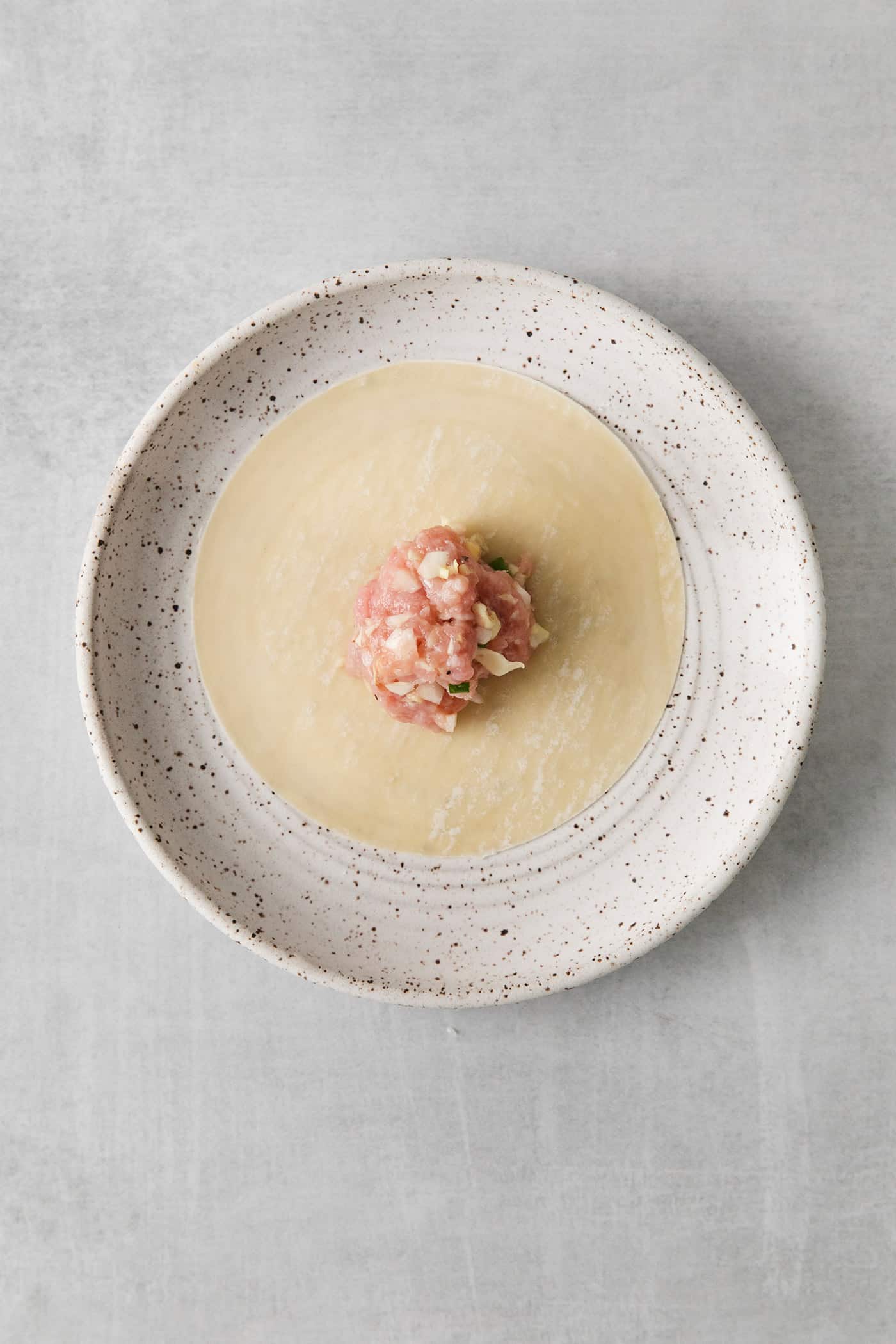

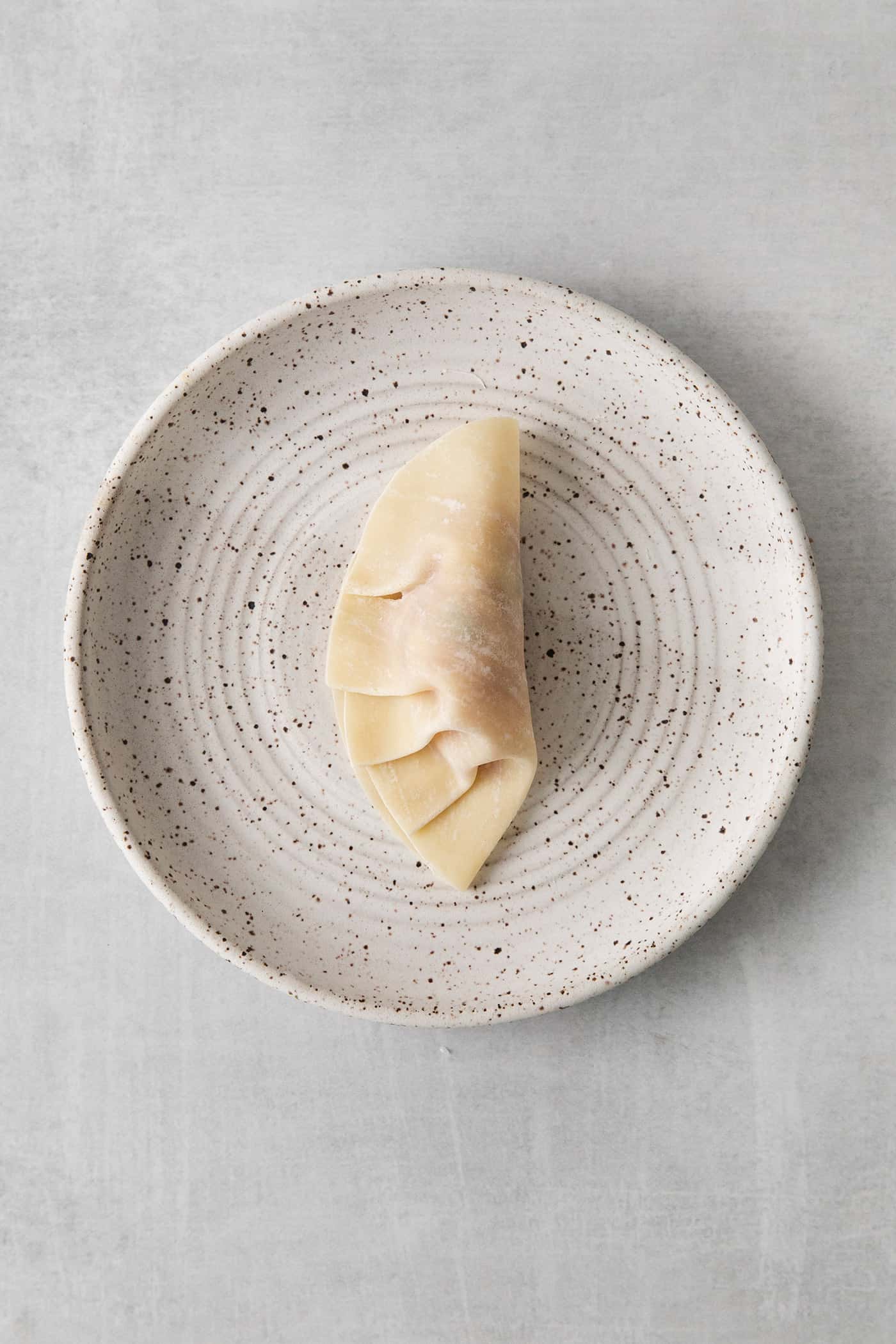
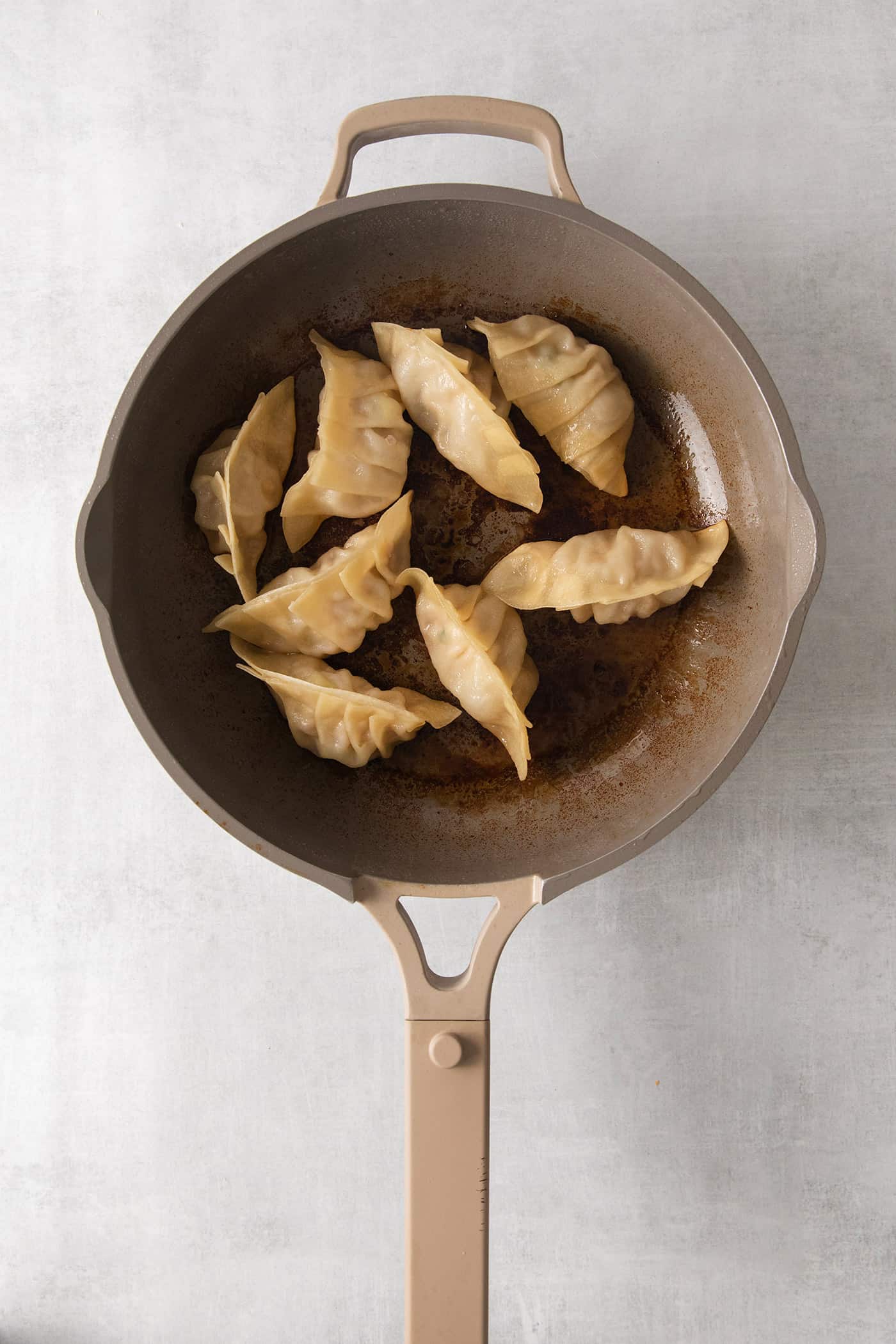

How to Make Potstickers
Potstickers are easy to make. Once you’ve pleated a couple, they come together quickly.
- Make the filling. Combine the potsticker ingredients in a bowl.
- Fill the wrappers. Add a teaspoon of the filling mixture to the center of a potsticker wrapper.
- Pleat the wrappers. See “How to Fold Potstickers” below.
- Repeat. Place each potsticker on a rimmed pan dusted with cornstarch (or line the pan with parchment paper) while you repeat the process.
- Cook the potstickers. Heat the oil over medium-high heat and swirl to evenly coat the pan. Add half of the potstickers, seam side up, and cook until golden brown on the underside. Add 1/3 cup of the chicken broth, reduce the heat, and cover the pan to steam. Cook until tender and the chicken broth has evaporated from the pan.
- Repeat. Repeat the process with the remaining potstickers.
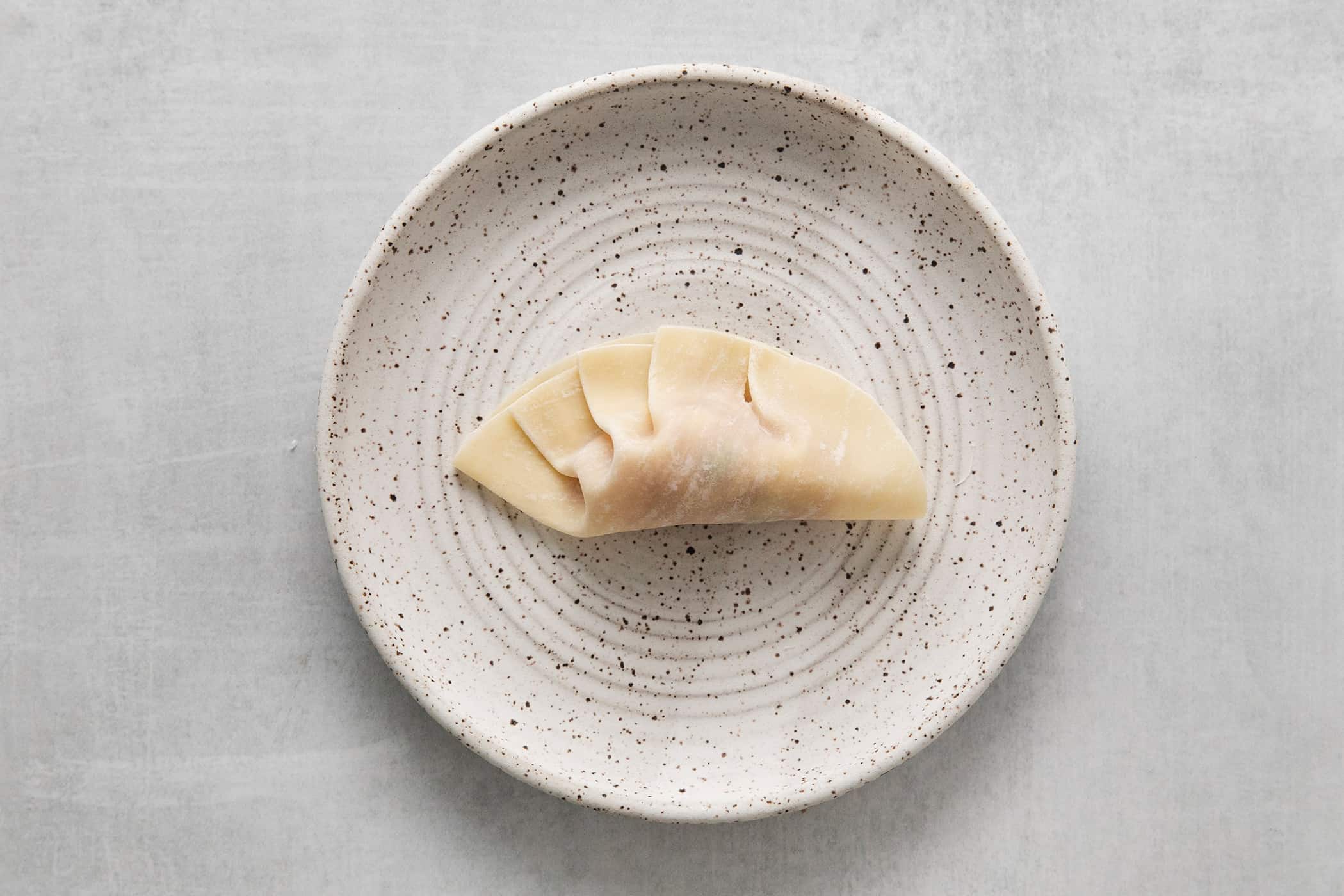
How to Fold Potstickers
There are many ways to pleat potstickers. If you do a quick search online you’ll see what I mean!
The pleating method shown in my photos and video is very basic, with wider pleats that all go in the same direction. It’s a great method for beginner potsticker makers that still offers beautiful dumplings.
Be sure to watch the video in this post – it’ll show you exactly how to pleat potstickers. These steps will also help:
- Wet the edge of the wrapper. Have a small bowl of water near and dip your finger into it. Run your wet finger around the outer perimeter of the potsticker wrapper.
- Form a half-moon. Fold the wrapper over the pork mixture to form a half-moon shape.
- Pleat. Then make small folds along the curved outer edge, to form pleats. Press each fold between your thumb and index finger to seal each pleat. Repeat until the curved edge is pleated/sealed. The water in Step 1 will help the folds stick together.
As you get more comfortable with the pleating process, you might want to adventure out into more detailed pleats. You could try narrower pleats, which equates to more folds, per potsticker. Or you could try pleating first from the center out to the left edge, then from the center out to the right edge. And that’s just a start – there are other options as well.
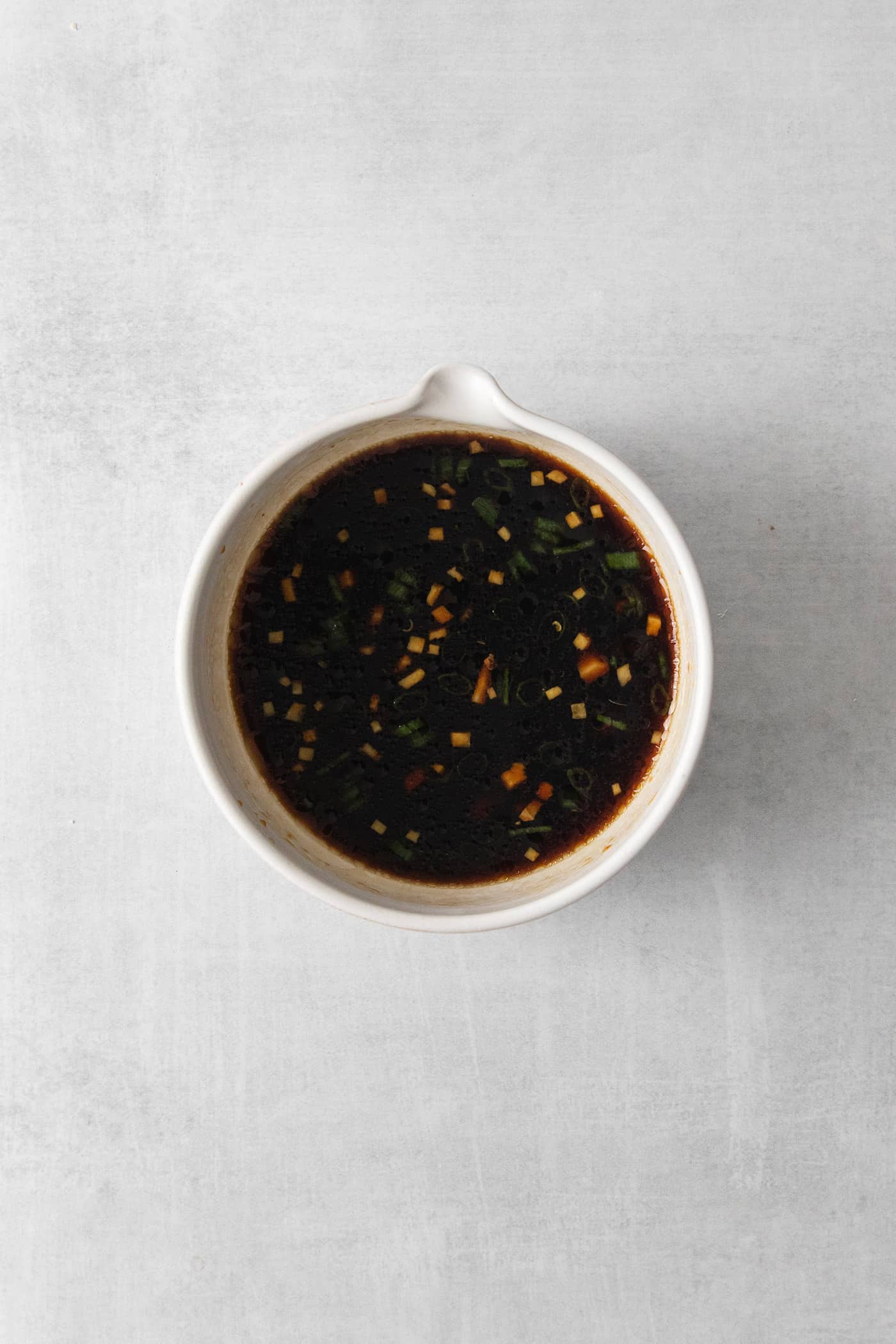
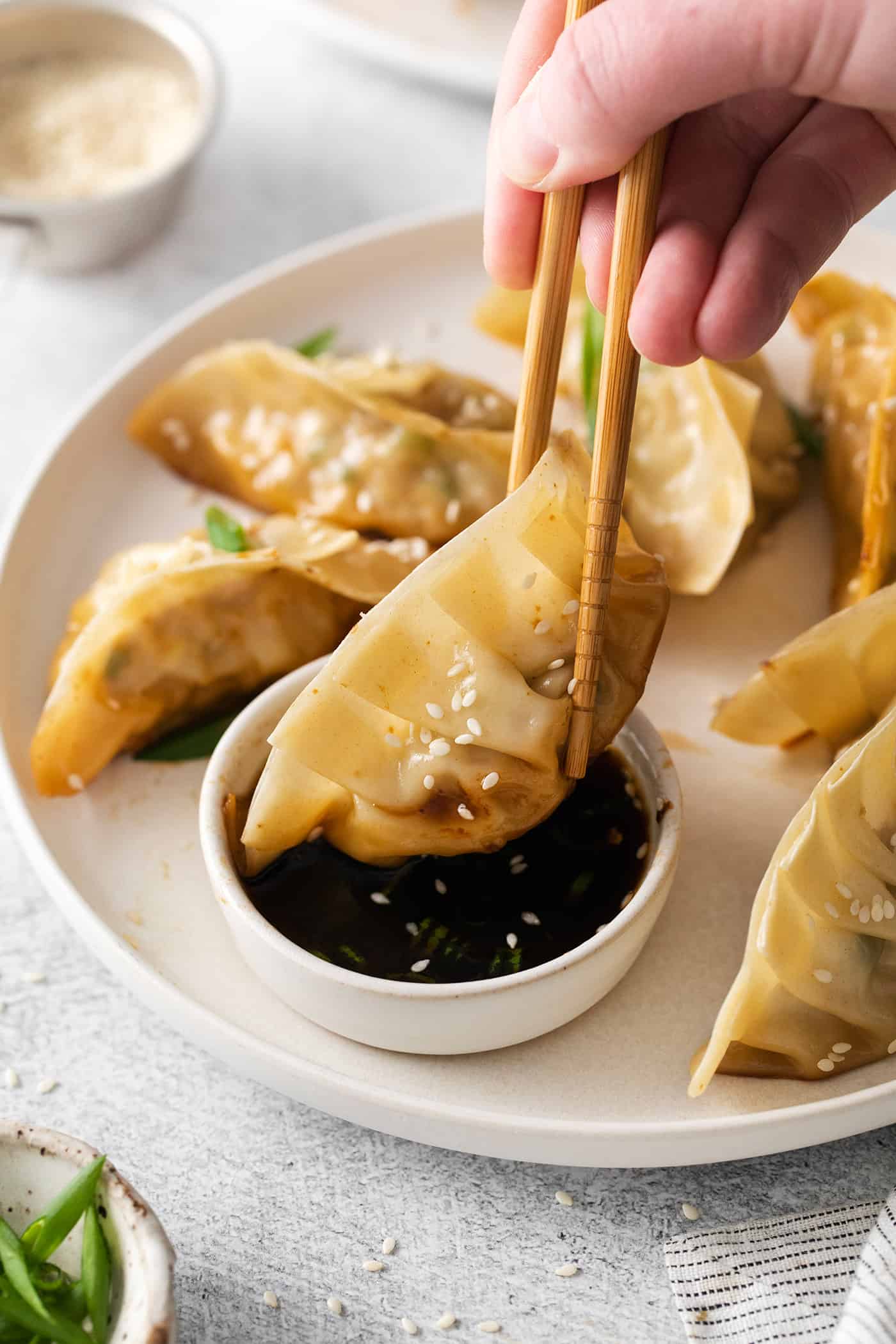
- Make the dipping sauce. Stir together the dipping sauce ingredients.
- Enjoy. Serve the hot potstickers with the dipping sauce (or plain soy sauce).
How to Steam or Boil Potstickers
The method I described above is the most common way to make potstickers and the way I recommend, as browning the bottoms adds so much flavor. However, you also have a couple other options:
- Boil the potstickers. Add the prepared potstickers to lightly boiling water or chicken broth. Cook until the potstickers float to the top, about 7 to 9 minutes. Be sure to not crowd the pan. This will give you potstickers that are completely soft, without the crispy bottoms.
- Steam the potstickers. You can also steam them in a bamboo steamer or metal steamer basket. Place them on top of a layer of lettuce, an inch or so apart, cover, and steam for 10 minutes. This method also gives you potstickers that are completely soft, without the crispy bottoms.

Tips for Making Homemade Potstickers
Here are a few tips for making these pork potstickers.
- Cover the wrappers. Dumpling wrappers tend to dry out easily at the edges if left out. So it helps to cover the wrappers with a clean dish towel as you are making the potstickers.
- Don’t add too much filling. If you add more than a rounded teaspoon of filling, you won’t be able to properly seal and pleat the potstickers.
- Seal them tightly. When pleating the tops, be sure to press each fold tightly to create a seal so the filling doesn’t escape. Dipping your fingers in water to wet the wrappers also helps to create that seal.
- Use the right skillet. Make sure to use a skillet with a tight-fitting lid so the potstickers will steam properly after you add the chicken broth. If you have a well-seasoned cast iron skillet with a tight fitting lid, use that – this will allow the potstickers to blister more, which will give crispier bottoms. Otherwise, a non-stick skillet will work fine.
- Use water instead of chicken broth. In a pinch, you can add water to the pan instead of chicken broth.
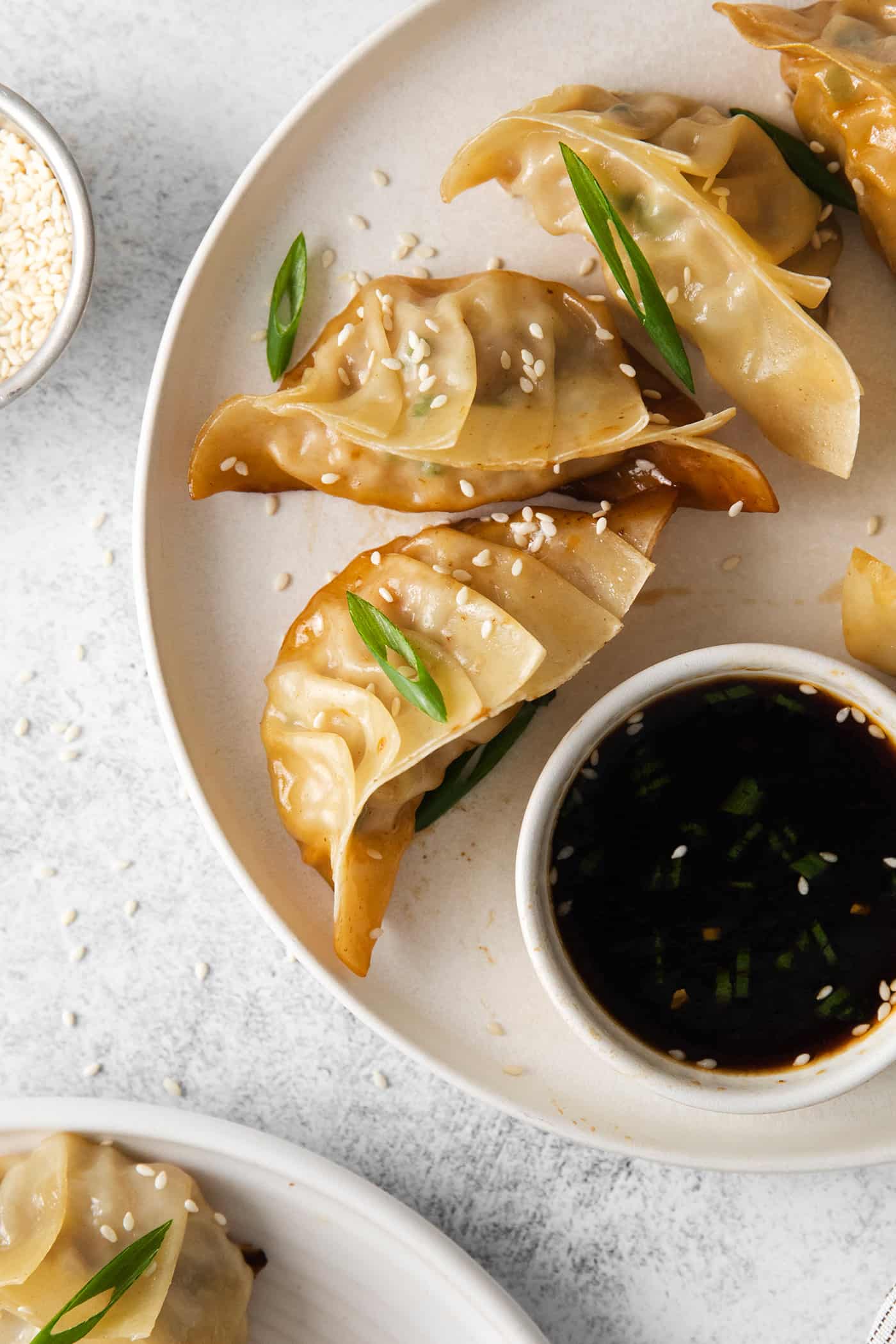
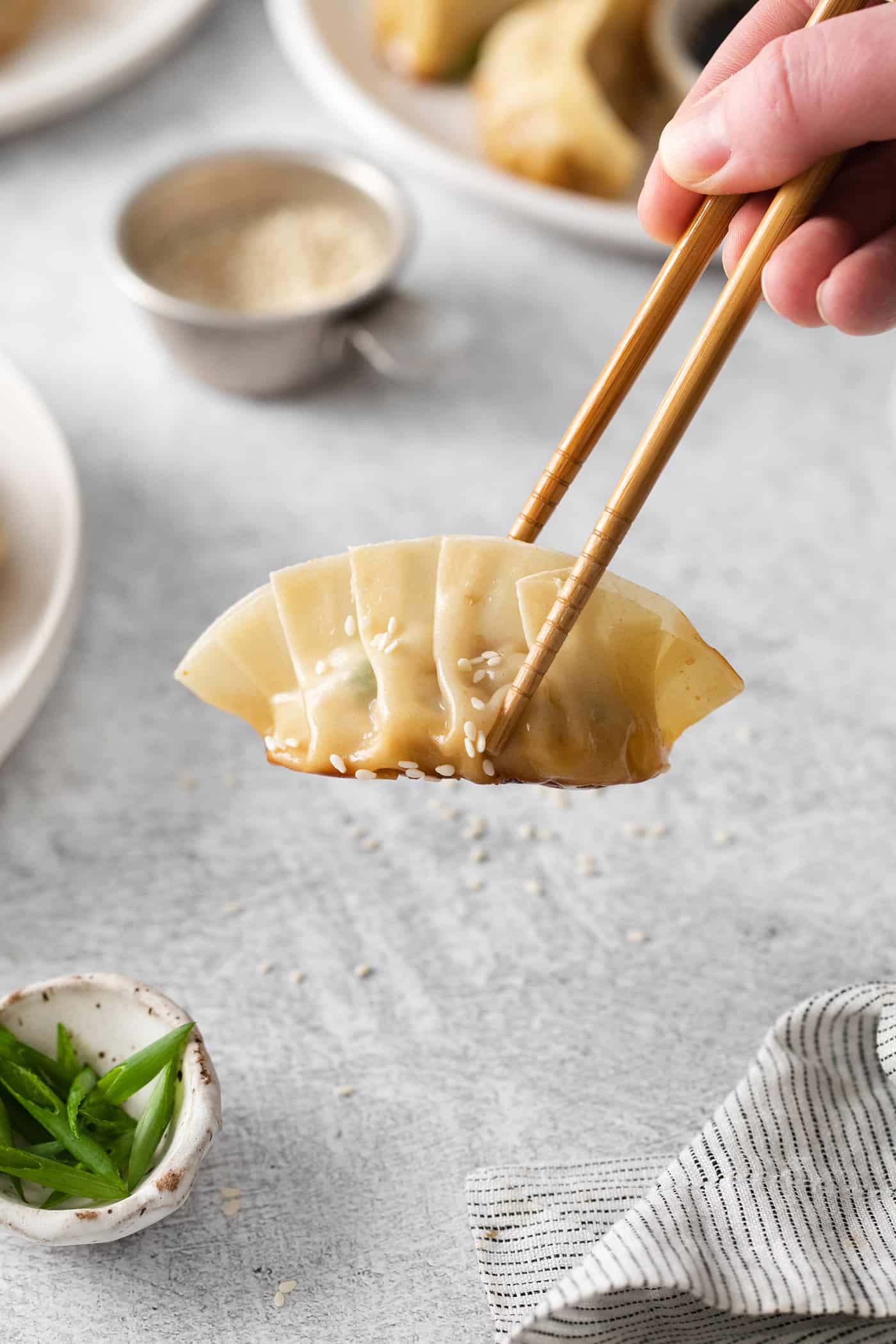

Serving Suggestions
Potstickers are typically eaten with chopsticks and can be an appetizer, a side dish, or even a main course (we love to call this a meal!).
I like to serve these pork potstickers with the dipping sauce I’ve shared in this post, but you can also serve them with just soy sauce or a sweet chili sauce.
Fried rice goes well with these, along with pretty much any Asian takeout dish – like Thai drunken noodles, easy Korean beef, coconut curry chicken soup, or Hunan beef.
How to Store & Reheat Leftovers
Store any leftover pork and cabbage potstickers in an airtight container in the fridge for up to 4 days. Reheat on the stovetop for best results, though the microwave will work in a pinch.
Can I Freeze These?
Yes, these homemade potstickers freeze very well! In fact, I always double the recipe just so I can freeze half of them. I figure if I’m going through the whole process anyway, might as well make some extra!
One thing to note: Do NOT refrigerate uncooked potstickers. The filling’s moisture will seep into the delicate wrappers and cause the dumplings to get soggy and lose their shape.
To freeze potstickers, place them on the pan as usual, cover them with foil, and flash freeze. Once frozen, transfer them to a freezer-safe container. Freeze for up to 3 months.
The really wonderful thing is that you can cook them directly from frozen. All you need to do is increase the cooking time by a minute or two!
More Asian Favorites:
Like this recipe? Save it to Pinterest!
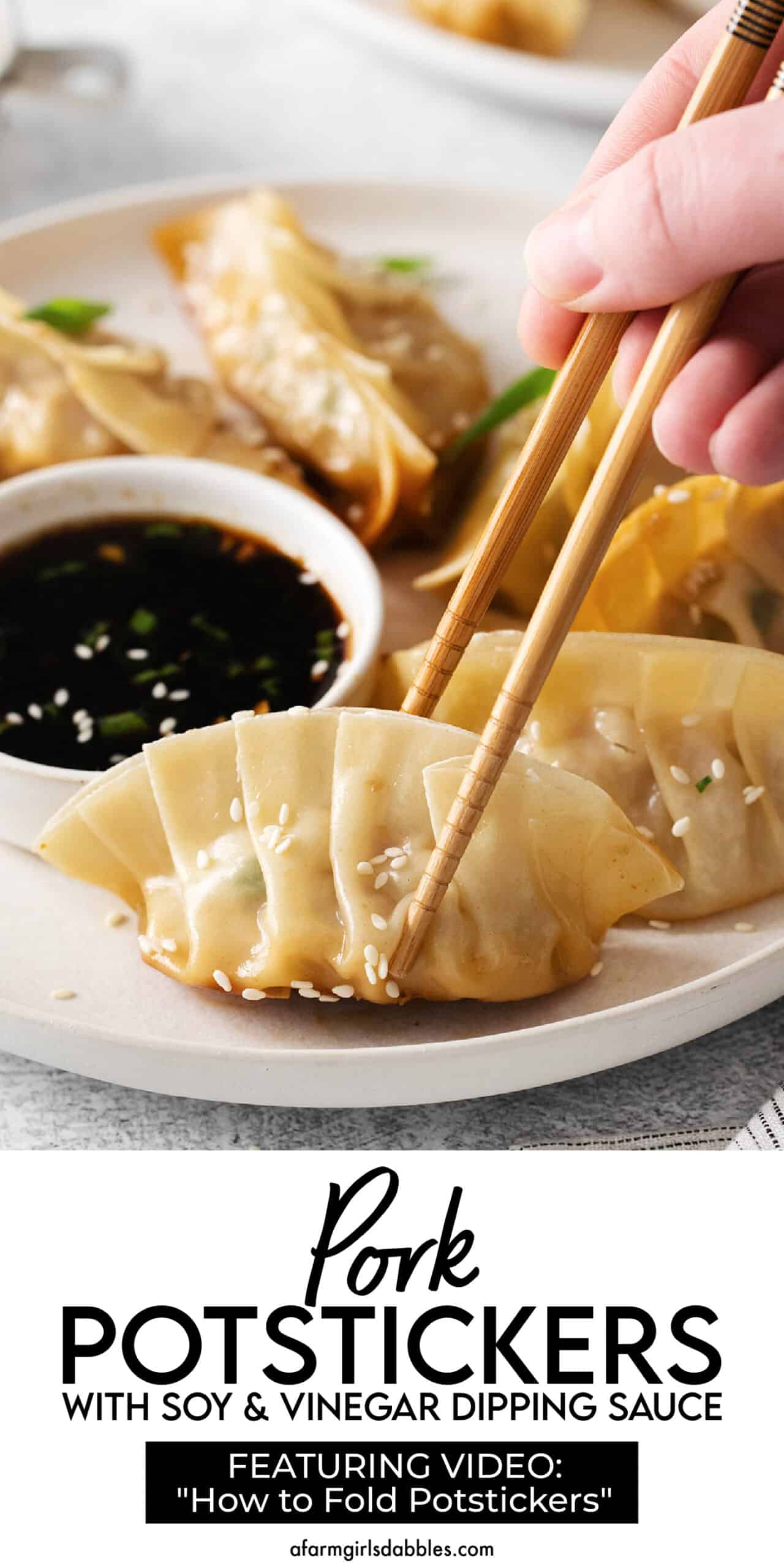

Potstickers
Ingredients
for the potstickers:
- ½ pound ground pork
- 1 cup finely chopped cabbage
- 2 green onions finely chopped
- 2 cloves garlic minced
- ½ tablespoon minced ginger
- 1½ tablespoons rice vinegar
- ½ tablespoon oyster sauce
- ½ teaspoon cornstarch plus more for dusting pan
- ⅛ teaspoon black pepper
- 1 12-ounce package round potsticker wrappers (35 to 40 wrappers)
- 2 tablespoons peanut or vegetable oil
- ⅔ cup low sodium chicken broth
for the dipping sauce:
- ¼ cup rice vinegar
- ¼ cup soy sauce
- 2 teaspoons honey
- 2 teaspoons chili garlic sauce
- 2 teaspoons sesame oil
- 1 green onion minced
- 2 teaspoons minced ginger
Instructions
- For the potstickers: In a medium bowl, combine the pork, cabbage, green onion, garlic, ginger, rice vinegar, oyster sauce, cornstarch, and black pepper.
- Place a rounded teaspoon of pork mixture onto the center of a potsticker wrapper. Have a small bowl of water near and dip your finger into it. Run your wet finger around the outer perimeter of the potsticker wrapper. Place a clean kitchen towel over the package of wrappers to keep them from drying out.
- Fold the wrapper over the pork mixture to form a half-moon.
- Then make small folds along the curved edge, to form pleats, and press to seal each pleat between your thumb and index finger. Repeat until the curved edge is pleated/sealed.
- On a tray dusted with cornstarch (or lined with parchment paper), set finished potsticker down firmly, seam side up, so that it will sit flat. Repeat process until all potstickers are made.
- In a large, deep skillet that has a tight-fitting lid, heat 1 tablespoon of oil over medium-high heat. Swirl the oil to evenly coat the bottom of the pan. Add half the potstickers (do not overcrowd – if your pan is not big enough to hold half the potstickers comfortably, then split them into 2 batches instead), seam side up, and cook until bottoms are golden brown, about 3 to 4 minutes. Add 1/3 cup of chicken broth, then reduce heat to low and cover the pan. Cook until potstickers are tender and broth has evaporated, about 6 to 8 minutes.
- Remove to serving platter and repeat the cooking process with the remaining potstickers. Serve hot with prepared soy & vinegar dipping sauce, soy sauce, or sweet chili sauce.
- For the soy & vinegar dipping sauce: In a small bowl, stir together all dipping sauce ingredients.
Video
Notes
Nutrition Information:


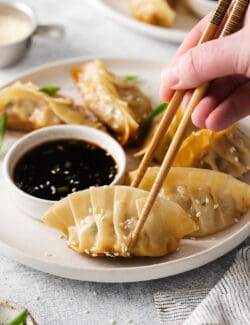
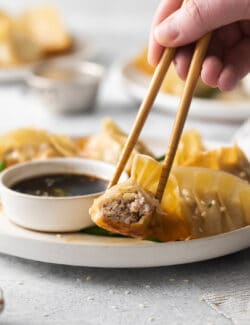
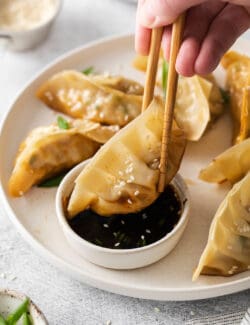
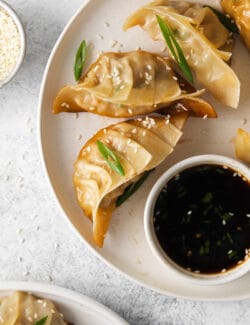
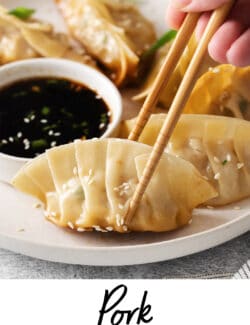
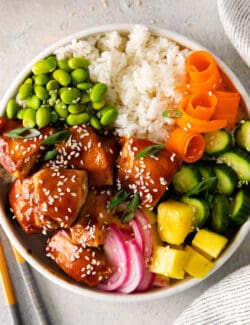
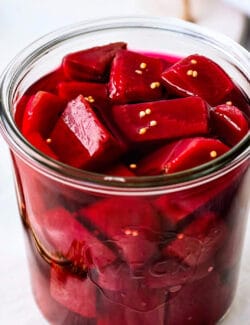
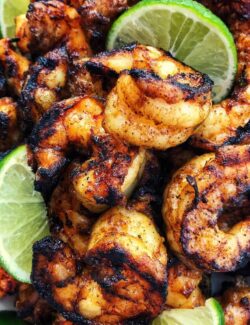
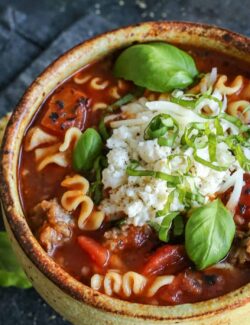
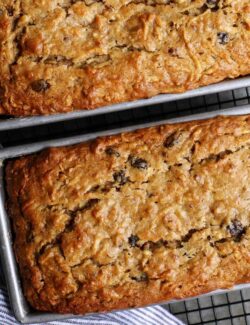

Hey Brenda! This recipe looks so tasty! Quick question, after you steam the first batch, do you need to clean out the pan before the next batch? Thanks!
Hi Jennifer! No need to clean out the pan in between batches. Hope you like this!
This probably won’t surprise you, but I’ve never had potstickers, haha. These do look very interesting. I’m going to have to remember this recipe for when I’m feeling adventurous.
I hope you had a lovely Christmas and I hope you’re having a good new year!
I am definitely going to be making these this week!!! Yummy!
I’ve never made these from scratch, I usually just buy the frozen variety. Maybe I should make the “real thing” sometime! These look so delicious!
Love potstickers, Brenda!! I can’t wait for the Lunar New Year now! :)
I love potstickers and have never made them on my own, but your recipe looks fantastic! I love the classic dipping sauce you typically get at a restaurant with potstickers and yours looks so flavorful!
Happy New Year to you and the family Brenda! All the best in 2013 for all of you. I can’t say that I’ve ever eaten a pot sticker but when I saw the first picture they made me think of won tons. Then I saw that you can use won ton wrappers to make them. I think are are quite similar to won tons are they, except that they are cooked differently? In any case, they look wonderful and a great appetizer for any celebration.
You’re completely right, Paula. They have the same basic makeup, but wontons are usually boiled or deep fried, and potstickers are pan seared and then steamed. And I love them ALL!! :) Happiest New Year to you and your family, Paula!
These look absolutely amazing and delicious!!! Thanks so much for sharing, Brenda! Happy New Year.
I could seriously eat 2 dozen of these by myself. Happy New Year sweets.
I believe I’ve done that before. ;) Happy New Year to you, too! xo
We love potstickers but have never made them. These look delicious so maybe we’ll give them a try this weekend.
Hi Rachel – please let me know if you try these!
Can’t wait to try these – I LOVE potstickers!!!
I remember when you made these for you us, and would love to have some again.
Sure thing!! xo
We love potstickers, too! Happy New Year, Brenda!
Happiest New Year to you and your family, Robyn!
Fabulous! I learned to make pot stickers in China a a teenager and it’s still one of my best cooking memories! :)
How awesome! I bet you have so many wonderful memories from your travels.
Can you believe I’ve never ate potstickers? I must try these soon!
If I had my way, I would eat potstickers (well, and sushi too) every day of the year. These look fantastic, Brenda! Happy New Year to you and your family!
I’m pretty sure I could survive on them, too! Thanks, Dara – and Happiest New Year to you and your fam!
I’ve never heard that about potstickers being good luck! I’ve always wanted to try making my own though.
Why can’t we be neighbors!?!? These look incredible…they are a favorite of mine!
I can only imagine all the good stuff we could pass back and forth across the fence! ;)
I love potstickers and often have a bag from TJ’s in the freezer. I’ll have to try making my own. Happy New Year!
Happy New Year, Laura! (Let me know if you give these a try!)
Thank you so much for sharing your recipe. I’ve been looking for a good pot sticker and dipping sauce recipe for some time now and this one looks pretty terrific. Can’t wait to try it. Happy New Year!
You’re welcome – hope you like it! Happy New Year!